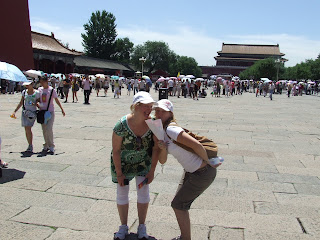

 volt.
volt.
6kor keltünk és 3man Gry (ő a norvég lány), Bandi és Klári elmentünk busszal Peking belvárosába, majd átmetróztunk a Tiltott városba a Tian' an Men térre. (Itt be kellett iktatni egy kis vásárlást, mert olyan melegünk volt Gryvel, hogy sapka nélkül már egy lépést sem tettünk. A képeken láthatók a sapka-ikrek :-)
Itt található még Mao mauzóleuma és a Zhengyang Men (történeti múzeum). Egyenesen a Tiltott városba mentünk csak előbb találkoztunk az itteni AIESEC ICXesével (gyakornokért felel)

A Mao kép alatt haladtunk át az első kapun, ez még nem a Tiltott város viszont a kép, azt a helyet jelzi, ahol Mao kihirdette a Kinai Népköztársaságot 1949. okt 1-jén. A Tiltott városba 60 yuanért lehet bejutni, diákoknak olcsóbb, de nemzetközi diákot nem fogadnak el. A Tiltott város Beijing egyik leghiressebb épitészeti komplexuma 1420ban készült el többször leégtek különböző részei. 500 éves múltja alatt több mint 24 császár uralkodott itt 1912 mikor az utsó császárt, Pu Yit eltávolitották a trónról. Azért tiltott város, mert közembernek tiltott volt a belépés. Sokat irhatnék. még a számok szimbolikájáról a yin és yang megjelenéséről, de erre van az útikönyv meg a google.
Érdekes volt, hogy a cserepek, amiket használnak az olyan, mint a mi szecessziós tetetőink. (a sárga olyan mint a földtani intézetünkben használt sárga)
Nem lehet a küszöbre lépni, mert az rossz szerencsét hoz, amúgy olyan magas, hogy nem is lehet kb rálépni. Nem megbotlik rajta az ember, hanem beleütközik.
Vannak ilyen apró kis páratlan számú szörnyetegek a tető szélén, ők védik az épületet a tűztől, mivel fából van a tető (asszem sárkányok). A sikerük megkérdőjelezhető, azt nézve, hogy hányszor leégett a komplexum.
Yesterday we had very touristic day a long but amazing one…
The 3 of us Gry (Norwegan girl), Bandi and me, we woke up at 6 am and we travelled to Beijing downtown by bus. We changed for the subway to get to Tian’ an Men square. But we had to stop by a shopping mall to get a cap to protect ourselves against sunrays. You can see the ’baseball cap twins’ on the picture.

Here on Tian’ na Men square there is Mao’s Mausoleum and the National History Museum Zhengyang Men . We met Tony the Local ICX responsible here and together with him, we entered the Forbidden City. It costs 60 yuan to get in, with an ID card it is a bit less but only Chinese ID cards are accepted.
On our way towards the ticket office we passed the place where Mao proclaimed the Democratic People’s Republic of China on 1st October 1949.
The Forbidden City, being Beijing’s most magnificent architectural complex, is a lasting monument of dynastic China. It was completed in 1420, 24 emperors ruled here during it’s 500 years history, until 1912, when Pu Yi abdicated the throne. It is named the Forbidden City because civilians were forbidden to enter it’s territory.
I could write a lot more about symoblics of numbers and the presence of yin and yang, but google and the guide book has more to tell to those who are interested in it. Below I collected a few things that were really interesting for me.
The tiles covering the wooden roofs here are very similar to our Art Neavou styled ones. (the yellow here is the same as the yellow shade used on the Geological Institute in Budapest)
You can’t step on the threshold here it brings bad luck. Just to avoid this happening, the threshold is so tall, that you would rather bump into it than actually step on it. (would be too big an effort)
The wooden roofs are protected against fire by these small animals (dragons most probably) associated with water and there is always odd number of them. I would question their success rate as the building complex was burnt down several times.






Nincsenek megjegyzések:
Megjegyzés küldése